World Water Day
World Water Day was yesterday. A day founded on the belief of equal access to clean water and dedicated to its conservation. The theme for 2022 is how climate change and water are linked. This is the perfect opportunity to talk about wetlands. Besides the carbon storage capabilities of wetlands, the impact of these communities is astronomical. Sadly, due to European settlement land development, about 4.2 million acres of wetlands have been lost. The passage of Michigan’s wetland protection law in 1979 reduced the decline, but many communities are still vulnerable. Continued conservation efforts for wetlands are more pertinent than ever.
A wetland is a type of ecosystem that is submerged in water year-round or seasonally. Due to Michigan’s geologic history, currently, 15% of the state is wetlands. All provide necessary ecosystem functions such as carbon storage, water filtration, flood storage, erosion control, breeding habitat for wildlife, and more. Many organisms like migratory birds, amphibians, threatened and endangered species depend on wetlands to survive. Currently, 43% of federally listed species are influenced by wetlands in some way.
Michigan has many different types of wetlands. There are 32 unique communities categorized into 6 ecological groups. Today we will just explore the 6 ecological groups. Wetlands consist of marshes, wet prairies, fens, bogs, shrub wetlands and forested wetlands.
Marsh
Marshes contain 9 unique communities. They are herbaceous wetlands that are either flooded or muddy, occur along lakes or rivers and are filled with aquatic vegetation, sedges, herbs or grasses. Fire is very important for marshes; it removes large woody vegetation that would otherwise take over the area. Beavers and muskrats can have a big impact on the ecosystem. Dams built by beavers control flooding and tunnels dug by muskrats created channels for water to flow. Both are vital in maintaining the hydrology of the marsh. Depending on the water level, a marsh can support a wide variety of fish, bugs, and amphibians. This provides an excellent food source for songbirds, shorebirds and other migrating birds. Along with food, marshes are nesting habitats for birds like Sandhill Crane and Canadian Goose. Some types of marshes remain secure and are not imperil (e.g. submergent marshes and emergent marshes), but many of the unique communities in this category are (e.g. Great Lake marshes and salt marshes).
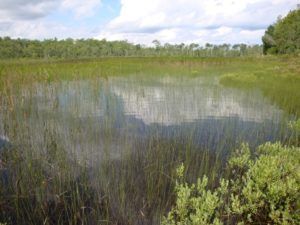
Wet Prairies
Wet prairies are very diverse communities that experience seasonal flooding. The vegetation composition consists of grasses, sedges and forbs. They are found in outwash plains formed by glaciers located in the southern portion of the lower peninsula. Much like marshes, wet prairies depend on fire to control woody plants and beavers to control flooding. These areas are important for many vulnerable species like the eastern massasauga rattlesnake, the short-eared owl, the spotted turtle and the prairie vole. Fire suppression, flood alteration, habitat destruction and the presence of invasive species threaten wet prairies, most of the distinct communities are considered imperiled.
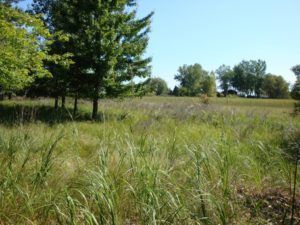
Fen
Fens are diverse peatlands that derive nutrients from groundwater or surface water. Peat is a type of soil that has very little decomposed organic matter and acts as a reservoir for carbon storage. The waterlogged conditions of a fen allow the peat to form. They are found in glacial outwashes and the vegetation is dominated by graminoids, forbs, shrubs, and stunted conifers. Fens provide the perfect habitat for small mammals such as shrews, voles, minks, and muskrats. Many different types of butterflies’ and moths’ habitats are restricted to fens. Currently, altered hydrology and the presence of invasive species are threatening the persistence of fens. Too much surface flow and reduced groundwater impend their long-term viability. All of the distinct communities of fen are imperil.
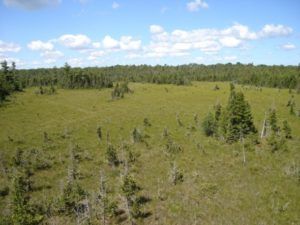
Bog
Bogs are diversity-poor, acidic, wetlands that occur in kettle depressions and glacial outwash. Bogs are great at storing carbon. The acidic and waterlogged conditions decrease decomposition and create the perfect environment for peat development. Sphagnum moss is the main vegetation type, but plants that can tolerate acidic conditions, like some shrubs and stunted conifer trees, can also grow. The diversity of bogs is low, some animals that do occur are swamp sparrows, song sparrows, small mammals, butterflies and moths. Some species of butterflies and moths are restricted to bogs. Restricting access and maintaining current hydrologic conditions will help to conserve bogs. Currently, one of the two distinct communities is considered vulnerable.
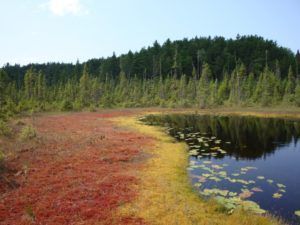
Shrub Wetland
Shrub wetlands grow in depressions and are flooded year-round or seasonally. The main vegetation type found in these communities is shrubs. Just like marshes, beavers play a big role in controlling the hydrology of the area. Moose, gray wolf, lynx, aquatic mammals and deer all benefit from the presence of shrub wetlands. Pools that form provide a breeding habitat for amphibians. Fruiting shrubs supply food for songbirds, ruffed grouse, woodcock and migrating birds. Even though shrub wetlands support a large diversity of organisms, the spread of shrubs into other wetland types can alter the biological functions provided and is not recommended. There is only one type of shrub wetland that is considered to be vulnerable, the main threats are hydrologic alteration through dams.
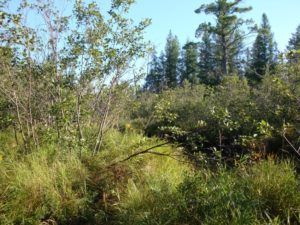
Forested Wetland
Forested wetlands are found in depressions, dominated by trees and can flood seasonally or year-round. The vegetation provides food and shelter for migrating birds, songbirds, canopy-dwelling species and the Indiana bat. Depressions in the landscape are locations for vernal pools, this is a seasonally flooded habitat with no presence of fish, they provide important breeding habitat for amphibians and aquatic invertebrates. Forested wetlands are often surrounded by agricultural land and are a haven for many species. It is important to limit timber harvest, maintain a hydrologic regime, minimize deer population, and control invasive species.
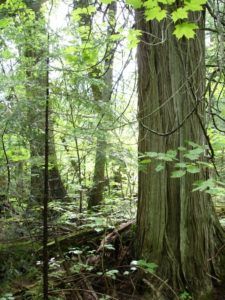
Wetlands are irreplaceable and need to be protected. Not only do they provide habitat for many endangered and threatened species, but they also perform irreplaceable ecologic functions. Filtering nutrients, reducing flooding in residential areas, storing carbon in peat, reducing erosion and replenishing groundwater. In Michigan, multiple wetlands are considered a part of Michigan’s Seven Wetland Wonders , a group of state game areas with vast opportunities for hunting, birding, and wildlife observing.
If you would like to learn more about the vast array of wetland communities and how you can help, click HERE . For information about the ecological function of wetlands, click HERE . To find out more about wetlands history in Michigan, click HERE . MUCC will be cleaning-up the Clinton River on April 9 th , if you weren’t able to celebrate World Water Day, register HERE .
The post World Water Day appeared first on Michigan United Conservation Clubs.



